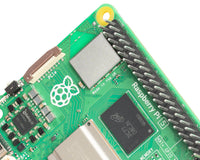
Raspberry Pi Roundup - 3rd October 2016
Arcade

Over at Adafruit, Philip Burgess has blogged about a marvellous little project involving a Raspberry Pi Zero. And when I say “little”, I mean “little”!
They’ve used the Zero, together with a 0.96″ OLED display, an amplifier, some tiny speakers and some buttons to create the world’s smallest arcade cabinet. They’ve then installed Mame on the Zero’s SD card, wired it all together and voila! Read about the project (which is not a step-by-step guide, they are keen to point out) over at Adafruit.
Air Drums!
David Pride, who previously created the wonderful motorised Connect 4 game, recently went to a car boot sale and found an “air drum” kit for £1. Taking this as inspiration, he has worked out how to connect two Wii controllers to his Raspberry Pi via Bluetooth and then play drum samples depending on the position and action of the controllers. Voila! A DIY air drum kit! You can read more about it here and download the code here. You can see the kit in action below.
Blinky Dress

Clodagh O’Mahony recently completed her thesis on Interaction Design. For her project, she constructed a dress which had a Raspberry Pi and an Adafruit Capacitive Touch Sensor Breakout (that’s the US link, for the UK, try Makersify!) embedded into it (under a 3D-printed shroud). Thanks to a lot of conductive thread, the dress detects touches in various places and logs the ‘social interactions’ to a database. The Pi then reads this data and lights up the dress in different colours with a Pimoroni Blinkt. The dress also registers vocal social interactions and reacts depending on whether the words are categorised as positive or negative. The data is also uploaded to a website where interactions are awarded points. You can read more over on Clodagh’s blog and see more pictures over on Instagram.
Ethernet

San Diego based Dave Johnson had a problem: he was due to be using his Raspberry Pi to demonstrate IoT applications using Node.js in a speaking engagement. This meant that he needed to be able to connect the Raspberry Pi to the Internet, and to his laptop, without worrying about network connectivity at the venue. So, how did he do this? Well, he used a combination of an Ethernet cable, Windows network connection sharing and Samba. Set-up in a particular (though not difficult) way, everything would work together as a private network but be able to use whatever Internet connection the laptop could provide. So, all he needed to do was to tether his laptop to his mobile and he could give his Raspberry Pi access to the net! You can read how to do it on his blog.





